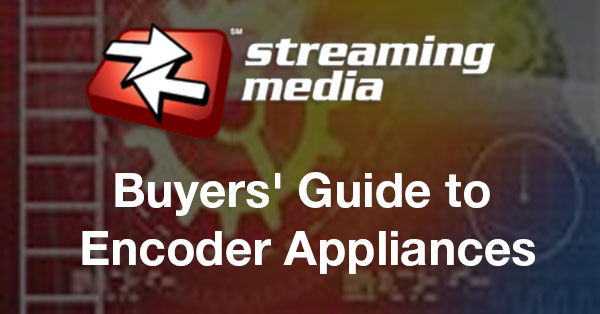Buyers’ Guide to Encoder Appliances
By Jim Bask
This Buyers’ Guide on encoder appliances will explore the tradeoffs between hardware and software encoding solutions, hopefully empowering readers to more easily determine which solution suits their specific needs.
The Hardware vs. Software Dilemma
In the early days of streaming, every format and codec was defined by its capability to deliver on-demand content in one of three ways: file downloads, progressive downloads, or streaming.
File downloads were fairly straightforward: a video file needed to be fully downloaded before playback could begin. On the other hand, progressive download files could start playing the content after a certain percentage of the file was downloaded, on the assumption that the file would download faster than it was played back. This meant the initial wait for the beginning of the file to download gave the patient end user a “head start” in playback that would, ideally, be devoid of buffering.
The third way, true streaming of on-demand content, required hefty hardware assistance in further compressing video content into data rates more akin to dial-up modem speeds than to CD-ROM data rates. To be honest, though, hardware assistance was needed for almost every early video codec, regardless of the data rate, resolution, or even frame rate.
In fact, the only codec in the first year of streaming media (the 1997–1998 timeframe) that had a software-only encoding option was MPEG-1 and its audio sidekick, the MP3 format. MP3, which has just reached the out-of-patent-protection stage after 20 years, was called that because it was the third audio coding format in the MPEG-1 video and audio standard ratified by the Moving Picture Experts Group (MPEG).
As more powerful general processors—whether general-purpose processors (GPPs) or central processing units (CPUs)—emerged, bringing with them an opportunity to move the next generation of video (MPEG-2) from hardware-only to software-only encoding solutions, there was often a sacrifice to be made in using software-only encoding: the final output often reduced the frame rates from 24–30 frames per second down to 10–15 fps to lower the overall encoding session length.
Part of the reason these software-only options didn’t cut it was due to the additional need to interweave the MP3 audio and MPEG-2 video elementary streams together in to a multiplexed stream suitable for transmission. This multiplexed, or muxed, file was often referred to by the acronym M2TS, for MPEG-2 transport stream.
This MPEG-2 transport stream technology, now more than 20 years old, still forms the basis for the majority of Apple HTTP Live Streaming (HLS), using a newer codec that replaced the MPEG-2 video codec: H.264, also known as MPEG-4 Part 10 or as Advanced Video Coding (AVC)….read more


